Updated
12-14-2004
To have a duplexer designed, engineered and custom-built
to your specifications which is rugged enough to withstand
shipping via UPS, e-mail me (Jim) here: "jvpoll
at dallas dot net". |
|
Note: a SIMULATION, so no real detail on making one.
Jump to my work Jan 2019
Six Meter Hybrid Ring
Heliax Duplexer by Jim WB5WPA
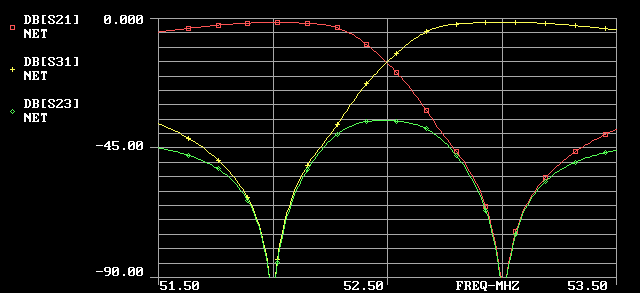
Low-band VHF Hybrid Ring
Heliax Duplexer Performance on 6 Meters
Shown above is a graphic displaying the performance of a Hybrid Ring
Duplexer using a 3rd generation design notch stub. This Hybrid
Ring duplexer is a 1 MHz split, 93 dB Isolation, less than
1.5
dB Insertion Loss, 4 stub Six Meter Heliax
Duplexer operating on a 52 MHz in / 53 MHz out
frequency pair.
Why a Hybrid Ring Duplexer? Two words: "Band pass". Utilizing a notch
stub in a Hybrid Ring configuration yields a band pass function
rather than the more usual notch or 'reject' function.
The graphic above shows the following "S21" S-Parameter sweeps for a
1 5/8" Heliax Duplexer using only 4 Heliax stubs:
-
S21 measurement, measured from the receive port to the antenna port (square/red
line --------),
-
S31 measurement, measured from the transmit port to the antenna port (plus
sign/yellow line --------)
and
-
S32 measurement, the 'isolation' a duplexer exhibits from receiver to transmitter
measured from the receive port to the transmit port (diamond/green
line ---------).
The Insertion Loss in the 'passband' of this duplexer indicates to be less
than 1.5 dB; this is excellent performance for a duplexer this size, this
weight and form factor, especially when compared against some of the cabinet-hoggers
and six-foot can designs that are doing service on VHF Low-band. S11 on
each port is equally impressive; over 20 dB RL on each port (see further
below for S11 sweeps).
This HR duplexer, modelled using 1 5/8" Heliax exhibits
around 1.5 dB IL for the Xmit and Receive legs each at their
respective 'pass' frequencies.
Experience has shown that
design (simulation/modeling) with such tools as Agilent/EESOF's Touchstone
with the correct constants in the 'coax' line statement results in a design
whose performance allies with the physical realization..
Note: RG-8 coax - Alan VK2ZIW
-- Hybrid Ring Circuit Configuration
--
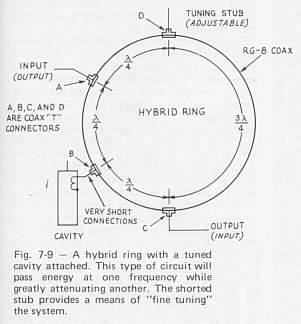 Q:
What is a Hybrid Ring?
Q:
What is a Hybrid Ring?
A: A 'Hybrid Ring' is an electrically circular configuration
of coaxial cable that posseses certain electrical properties that enable
electrical isolation to be achieved in a different manner than that achieved
using the usual band-pass or band-reject circuit configurations.
A Hybrid Ring circuit configuration is used to turn a notch
element into a bandpass element through the magic of signal
cancellation; the total length around the ring is 6/4 (or 1 and
1/2) wavelengths total. Now note the difference between the two 'path
lengths' between the INPUT and OUPUT points: a) 1/2 wavelength going counter-clockwise
past the CAVITY and b) 1 wavelength going clockwise around
the other way; if one sends a signal into the port labelled INPUT nearly
total signal cancellation occurs at the port labelled OUPUT (assuming the
CAVITY or stub is not present or active) because of the total path length
difference is 1/2 wavelength, and signals that are 1/2 wavelength
(or 180 degrees) out of phase cancel (assuming equal amplitudes).
Now note the placement of the the 'cavity' (or notch stub) located midway
between two points marked INPUT and OUTPUT; at the frequency the stub is
tuned to, the 1/2 lamda 'path' is effectively 'shut off' by the short
created by the notch stub between those two lengths of 1/4 wavelength cable;
the short created by the stub also becomes effectively an open through
the 1/4 wavelength cable at the INPUT and OUTPUT ports, and the 'signal
cancellation' we had moments ago now goes away; the Hybrid Ring now exhibits
a 'band pass' characteristic at the frequency the CAVITY (or stub in our
case) is tuned to.
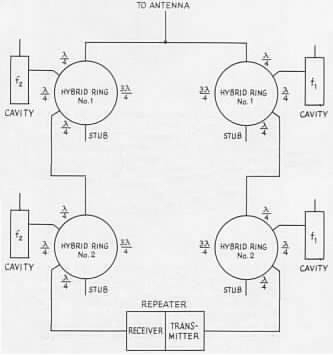 2b)
BP - Band Pass, as realized in a Hybrid Ring configuration using tuned/resonant
elements which 'notch' one particular frequency in the Hybrid Rings in
the transmit and receive legs.
2b)
BP - Band Pass, as realized in a Hybrid Ring configuration using tuned/resonant
elements which 'notch' one particular frequency in the Hybrid Rings in
the transmit and receive legs.
The image to the left shows how the four band pass Hybrid Rings (two
for transmit and two for receive) are connected for use in a HR bandpass
duplexer.
The length of cable to the common antenna port, although not shown,
would be a 1/4 wavelength of cable from each Hybrid Ring to a common point
(like a UHF or BNC 'Tee" connector) known as the Antenna Port.
Note: What do we adjust to get High & Low sides? - Alan VK2ZIW
Do we lengthen or shorten the loop or is it all in the stub tuning?
Band Pass Duplexer Performance - HR
configuration
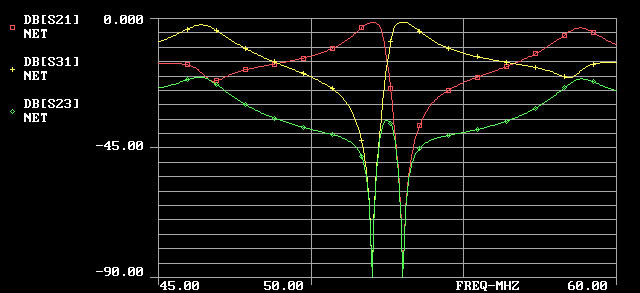
Sweep frequency range 45 MHz to 60 MHz of the 4-stub HR Duplexer encompassing
TV CH 2 (54 - 60 MHz). For this sweep the following parameters were measured:
-
S21, Red, Receive leg performance measured from Receive port to antenna
port.
-
S31, Yellow, Tranmit leg performance measured from Transmit port to antenna
port.
-
S23, Green, Transmit to Receive Isolation Value, mesured from Transmit
port to Receive port.
Note the amount of attenuation offered by the Hybrid Ring Duplexer
over a broad range of frequencies compared to the Notch duplexer shown
below; this is the major feature of this design.
Band Reject Duplexer Performance - Notch configuration (for comparison
with HR duplexer)

Sweep frequency range 45 MHz to 60 MHz of a 6-stub Notch Duplexer encompassing
TV CH 2 (54 - 60 MHz). For this sweep the following parameters were measured:
-
S21, Red, Receive leg performance measured from Receive port to antenna
port.
-
S31, Yellow, Tranmit leg performance measured from Transmit port to antenna
port.
-
S23, Green, Transmit to Receive Isolation Value, mesured from Transmit
port to Receive port.
It is obvious that the BR (band reject) or Notchs only act to notch
basically two frequencies: the transmit and receive frequencies.
Return Loss (VSWR)
I prefer using the term return loss to SWR or VSWR since so very
few of us actually measure 'VSWR' directly; usually, we measure return
loss using a directional coupler (or a directional Watt meter like
the famous Bird series) and convert this figure to VSWR using the usual,
well-established formulas and via HP's APPCAD utility or the venerable
HP VSWR "Reflectometer" slide rule.
To that end, the following close relationships exist between Return
Loss and VSWR:
|
Return Loss
|
VSWR |
| 14 dB |
1.5:1 |
|
18 dB
|
1.3:1
|
| 21 dB |
1.2:1 |
| 26 dB |
1.1:1 |
The return loss value, directly related to the VSWR (Voltage
Standing Wave Ratio), is a measure of the match the duplexer presents
to the transmitter, the receiver, and even the antenna. Below is the sweep
obtained during modeling of a Heliax duplexer design. Practical experience
shows that comparable results can be achieved when building the Heliax
duplexer - Return Loss values better than 20 dB translating to a VSWR of
around 1.2:1 can be achieved with proper design and tuning.
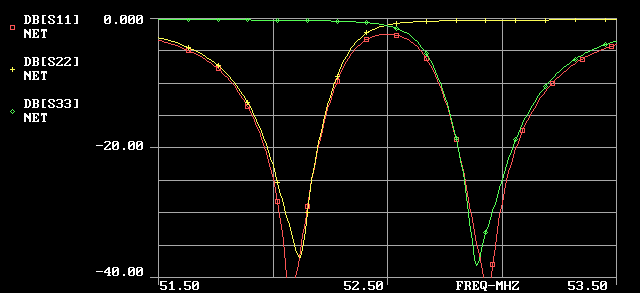
Sweep frequency range 51.5 MHz to 53.5 MHz of the 4-stub HR Duplexer.
For this sweep the following parameters were measured:
S11, Red, Antenna leg RL performance.
S22, Yellow, Receive leg RL performance.
S33, Green, Transmit leg RL performance.
Commercial product - comparison
For comparative purposes, via www.repeater-builder.com/rbtip/duplexerspecs.html
we can see what the key performance parameters are for a commercial DB-4032
(an 8-can helical resonator VHF low-band duplexer):
---------------------------------------
Type: 8 helical resonators, bandreject
Minimum freq. spacing 0.5 MHz
Insertion loss
2.0 dB
Max. continuous power 150 watts
Tx noise supp. at Rx freq. 80 dB
Rx isolation at Tx freq. 80 dB
VSWR
1.5:1
---------------------------------------
-- History --
The history of duplexer design for Six Meters using Heliax stubs dates
back to the late eighties when I began several years of low-level research
involving the mathematical analysis, simulation and 'bench work' on shorted
Heliax stubs; work that finally culminated in a proof-of-concept
prototype design
of a notch duplexer in about '91 which
was constructed out of 1 1/4" Heliax.
Duplexer design, website issues, or to have a duplexer built for use
on your VHF low-band commercial (30 - 50 MHz ) repeater or for the
6M
Amateur band e-mail Jim (call sign: WB5WPA) at "jvpoll
at dallas -dot- net" (Be sure to remove the at
and -dot- and spaces and replace as required).
* * * * * * * * * * * * * * * * * * *
Copyright Notice: The author would like to retain any and all rights
to images, text or other creative works (including pictures, sketches,
hand or machine drawn art) appearing on this page. Also, should derivative
works be created based on this work it is asked that reference or cite
be made to same in the 'references' section of said derivative works.
Jan 2019: Email from Jim WB5WPA This was a SIMULATION.
He did not build a Hybrid Ring. He did build a notch type.
An email from Steve N8AR, advice, convert to series loop BP/BR.
SteveN8ARemail.html
My work
------- My work thus far Jan 2019 ------
Q/ Can the Hybrid Ring make small cans useful?
I've constructed a Hybrid Loop for 2m in 1/4" heliax, filed notches in it and soldered on tails
of RG223 for the in and out and the stub. No stub yet.
PocketVNA
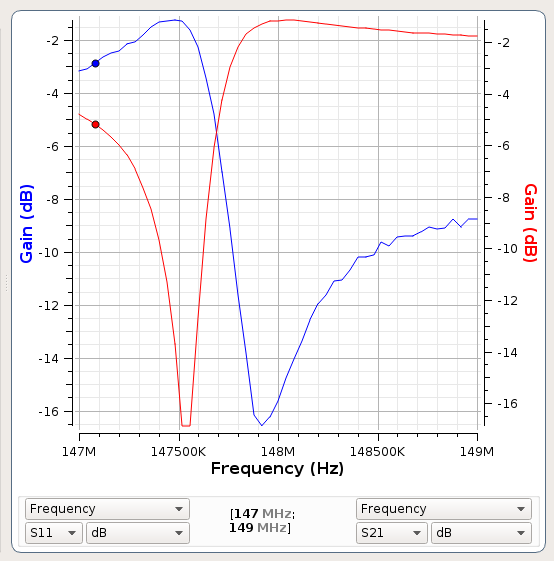
Cavity is a 6" RFS with about a 2 sq. inch loop in 3/8" copper strip.
the Hybrid Loop was cut for 147MHz, but was about 153MHz.
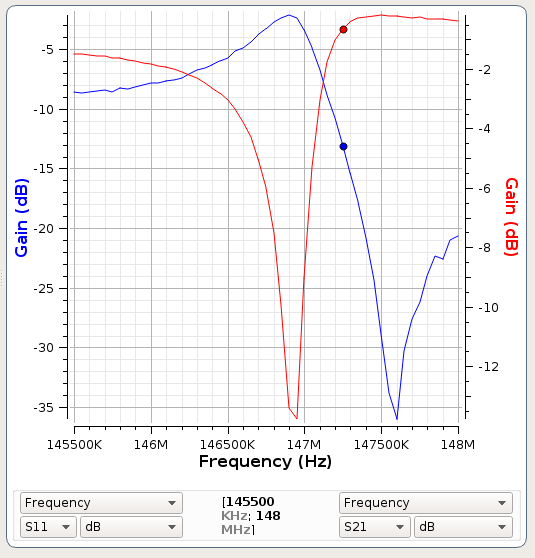
With 10p cap (trimmer) on the stub port. Now with a decent notch depth.
Tuning the cavity lower reduces the notch depth.
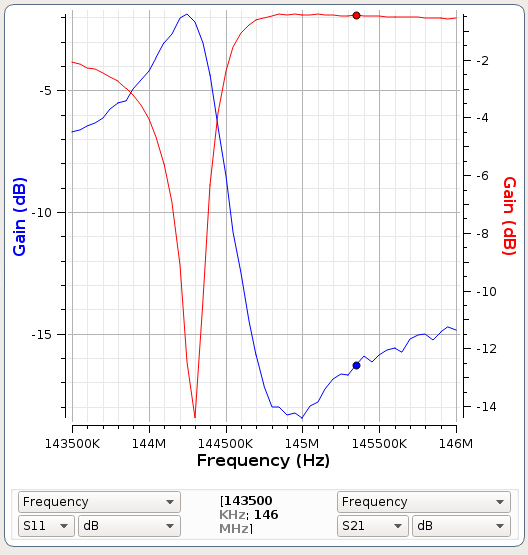
Tuning the cavity higher also reduces the notch depth.
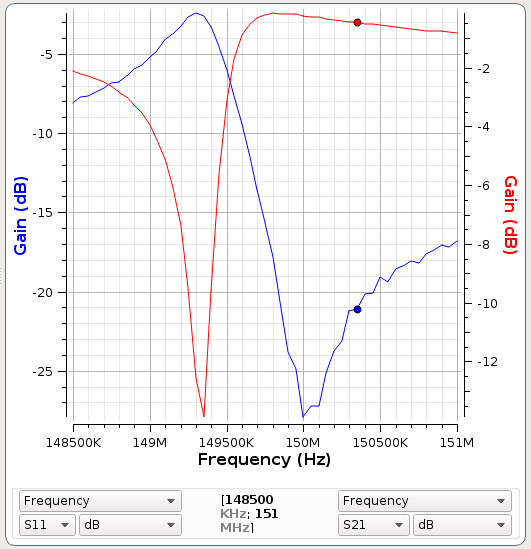
Now I need to try inductance. This is not easy: 2 turns 1/4"
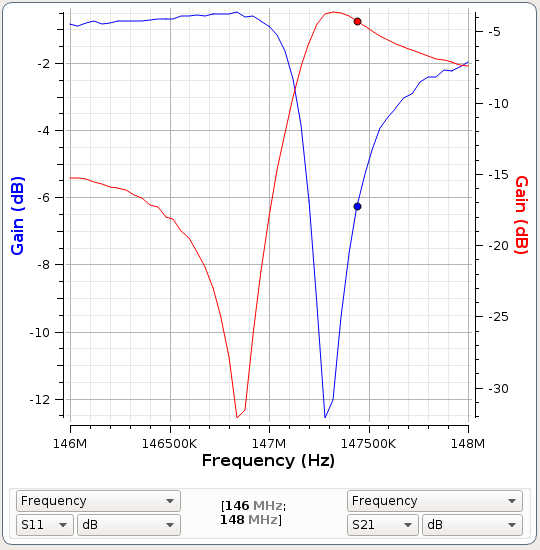
Note, it didn't move the notch. I need to swap to notch then pass.
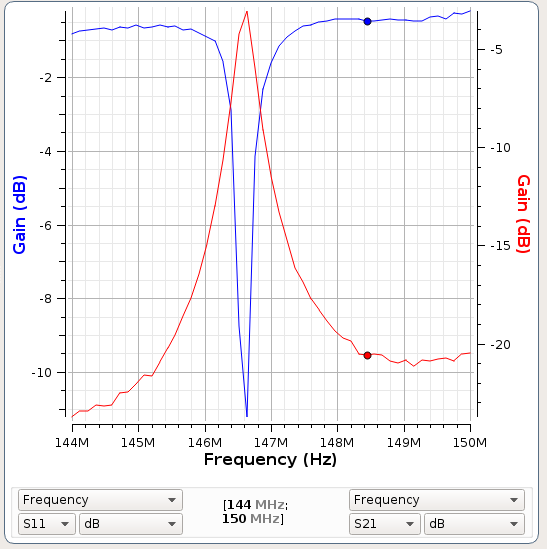
As small L as I can, straight 1 in. wire 0.3mm
Scan of the bare hybrid loop, I should have started here.
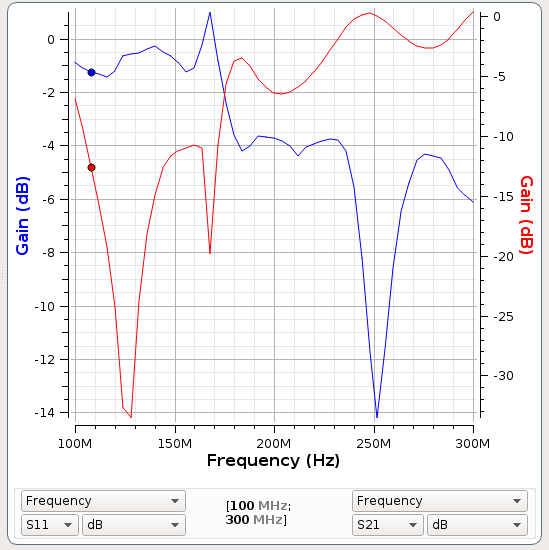
I was expecting an obvious notch where the 180 deg signal would neatly cancel as the Sinclair
document intonated.
Should I have scrapped the heliax and gone for RG-213 for my first test run? Jim's article above I thought used 1/4 in. heliax. I measured the lengths and they are right 920mm for 1/2 wave and 1840mm for a full wave.
No, email from Jim, ring was 1.25 in. heliax, a simulation.
Measured again with the Atten AT-5011A and the pieces are on 120MHz, measured VF as 0.74.
Cut and soldered up again, 1/4 in. heliax, no cavity, notch 153MHz. With resonable attenuation out 25MHz each side.
I moved the coaxes further apart at the cavity in an attempth to bring the notch down but it went up, 156MHz.
This is more tricky than I expected, adjusting the ring circumference.
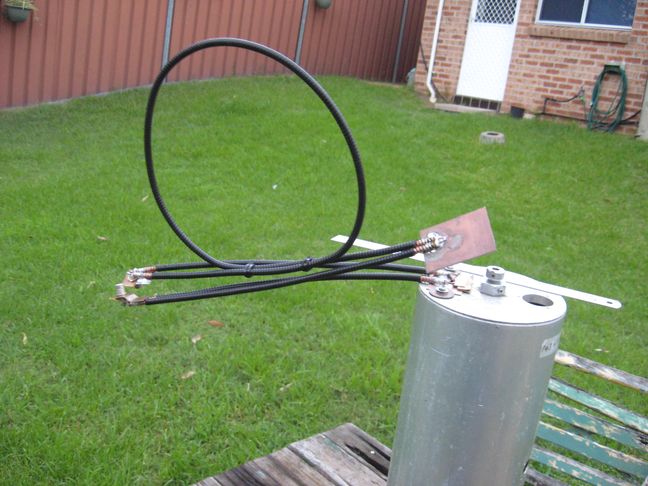
With a trimmer, 10p across the cavity, I have notch then pass, 1MHz split, not yet optimised.
Again, how to swap the notch & pass ?
New software for Pocket VNA. NB. Turn mobile phone off !!!! RF leakage into the VNA throws it way out.
Do not use: pocketVna281018.CentOs6x64.run it gave double the notch depth!
New software for Pocket VNA. Ver 1.02 Downloaded 23 Jan 2019.
Still fiddling with the line lengths, small open air link on the stub PCB.
Bare ring. This 1/4 in. heliax is quite good enough.
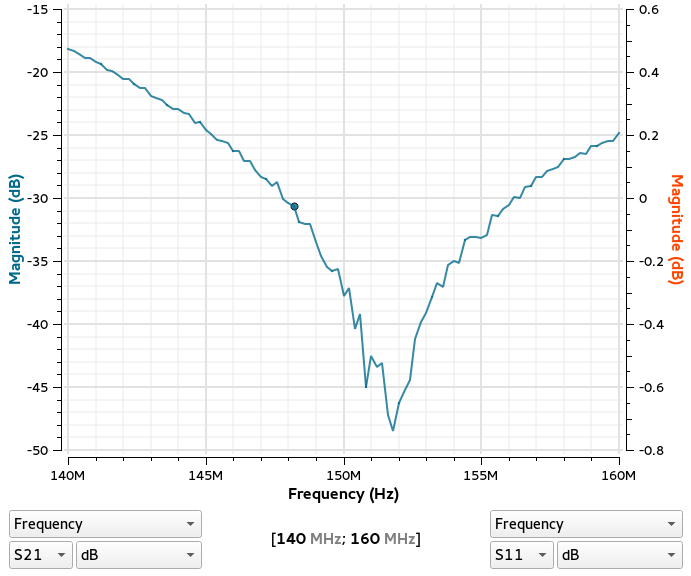
With cavity:
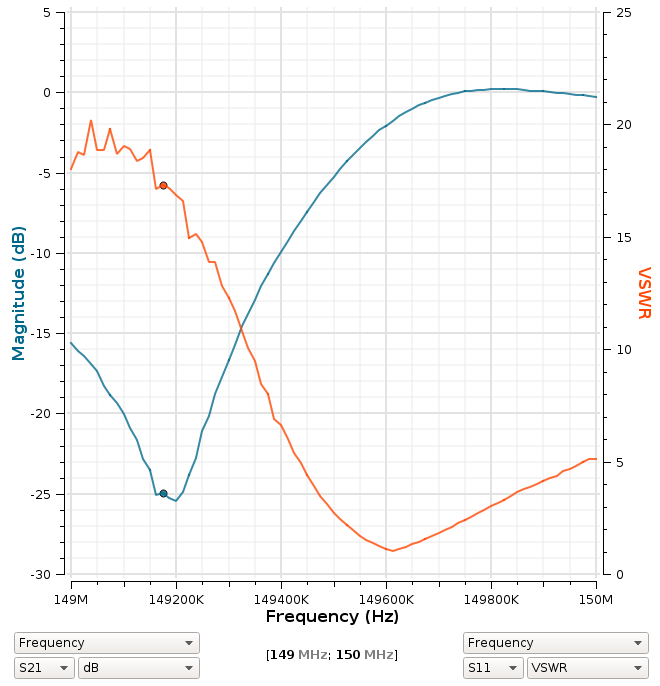
Small 1t 1/4 in. coil on stub port:
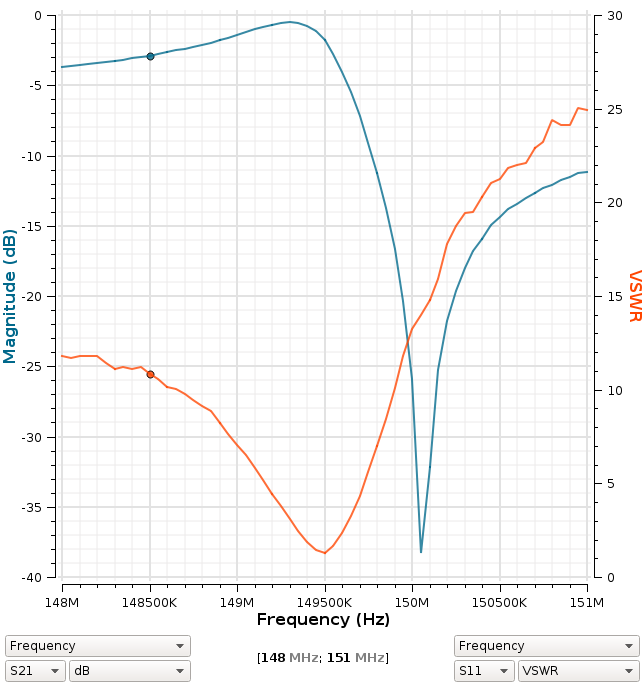
A wider scan
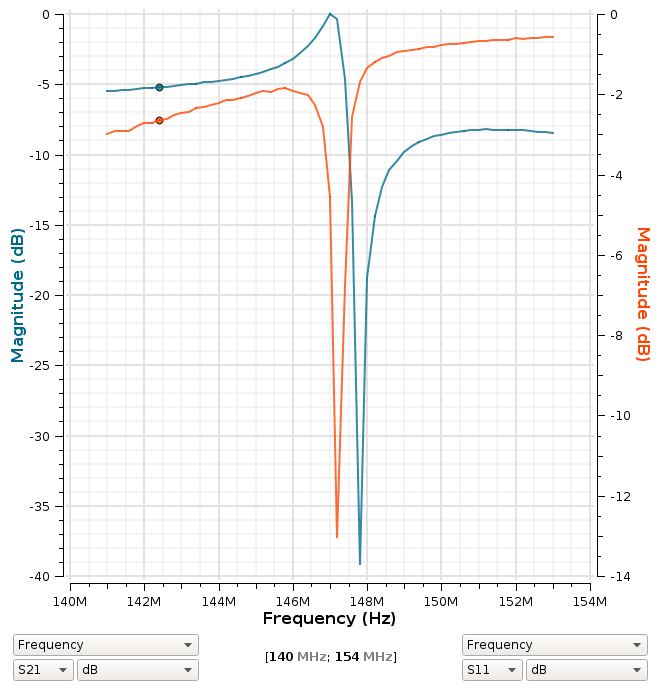
Hybrid ring in RG-213
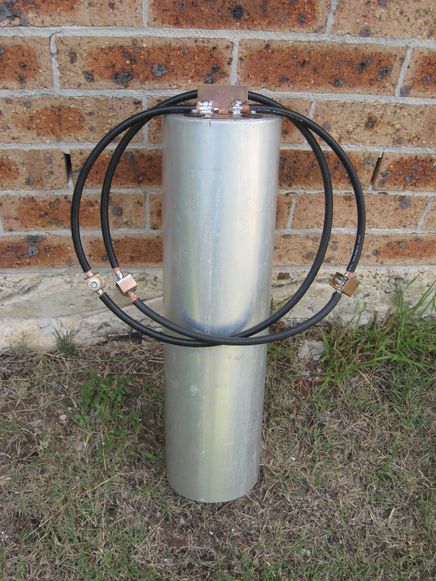
It's good enough, hopefully not too much leakage through the braid.
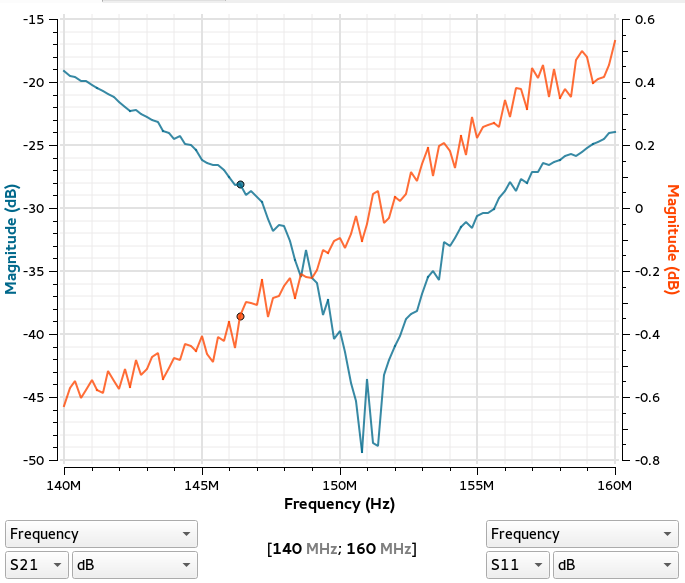
Cavity in, 330R resistor on stub port, Rx cavity perhaps!
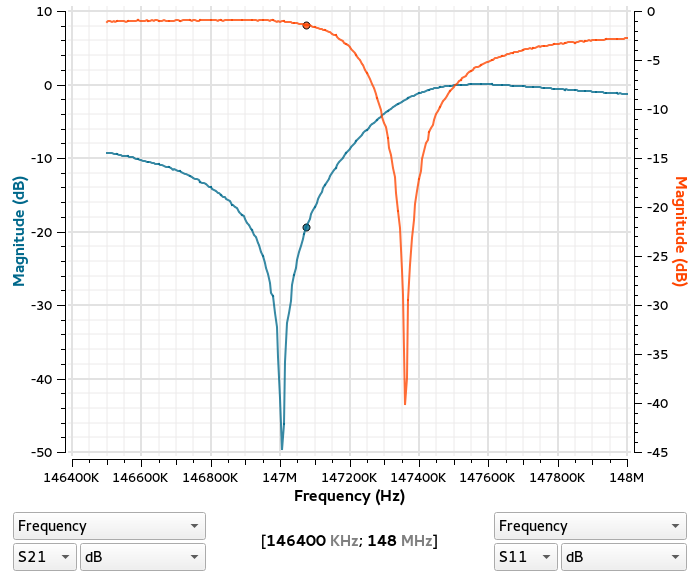
That's more real.
Back to the heliax, with a small L and 1K on the stub port.
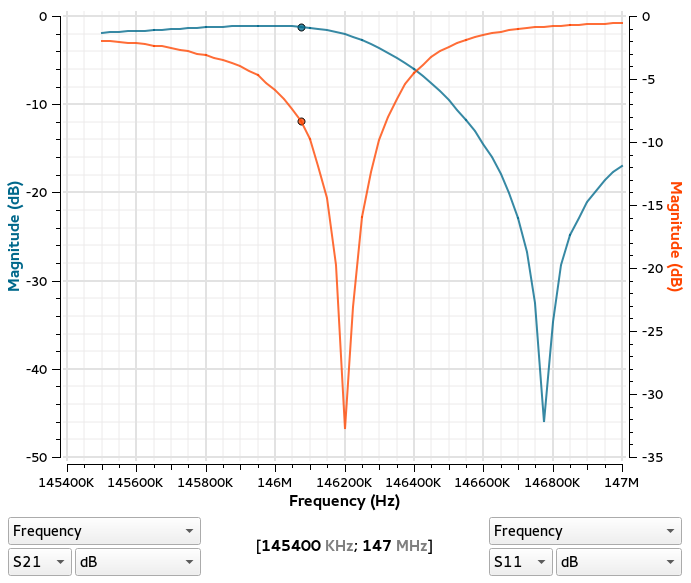
That's impressive but the 1K resistor, could limit high power use.
Adjusting the notch, ring circumference:
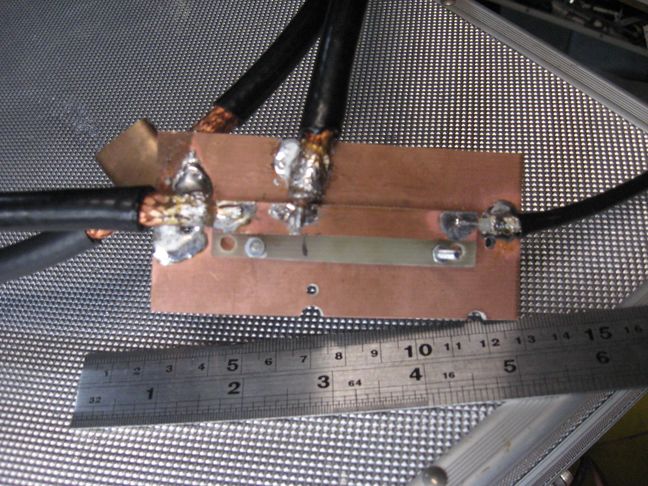
The ring is the thick coax.
Setup with cavity and 1.2K on stub port.
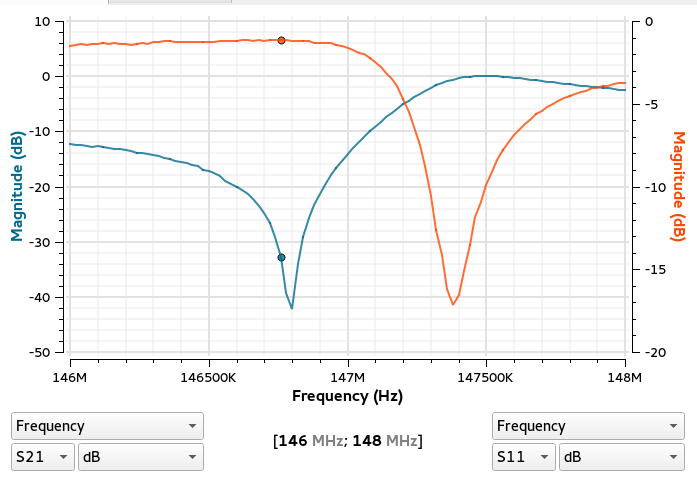


 Q:
What is a Hybrid Ring?
Q:
What is a Hybrid Ring?
 2b)
BP - Band Pass, as realized in a Hybrid Ring configuration using tuned/resonant
elements which 'notch' one particular frequency in the Hybrid Rings in
the transmit and receive legs.
2b)
BP - Band Pass, as realized in a Hybrid Ring configuration using tuned/resonant
elements which 'notch' one particular frequency in the Hybrid Rings in
the transmit and receive legs.




















